The War on Drugs | Eliza Hardy Jones | Interview
The mind is an amazing thing, especially when it comes to music. Eliza Hardy-Jones is a sincerely talented musician with a long rich family history of seeing, hearing and expressing music in a wide variety of manners.
I’ve known the members of the band War On Drugs for more years than I care to remember, and it’s been a pleasure getting to know their newest member Eliza as well. She’s one of those women who inches a mile wide smile across my face, she’s a pleasure to be around, and just when I think I know who she is, she shows me a side of herself that’s totally new, inspiring and delightful. To that end, music isn’t all about the guitar, the piano or even the singing, there are sides of music that are so vast and wondrous, all we need to do is take the time to experience the side avenues.
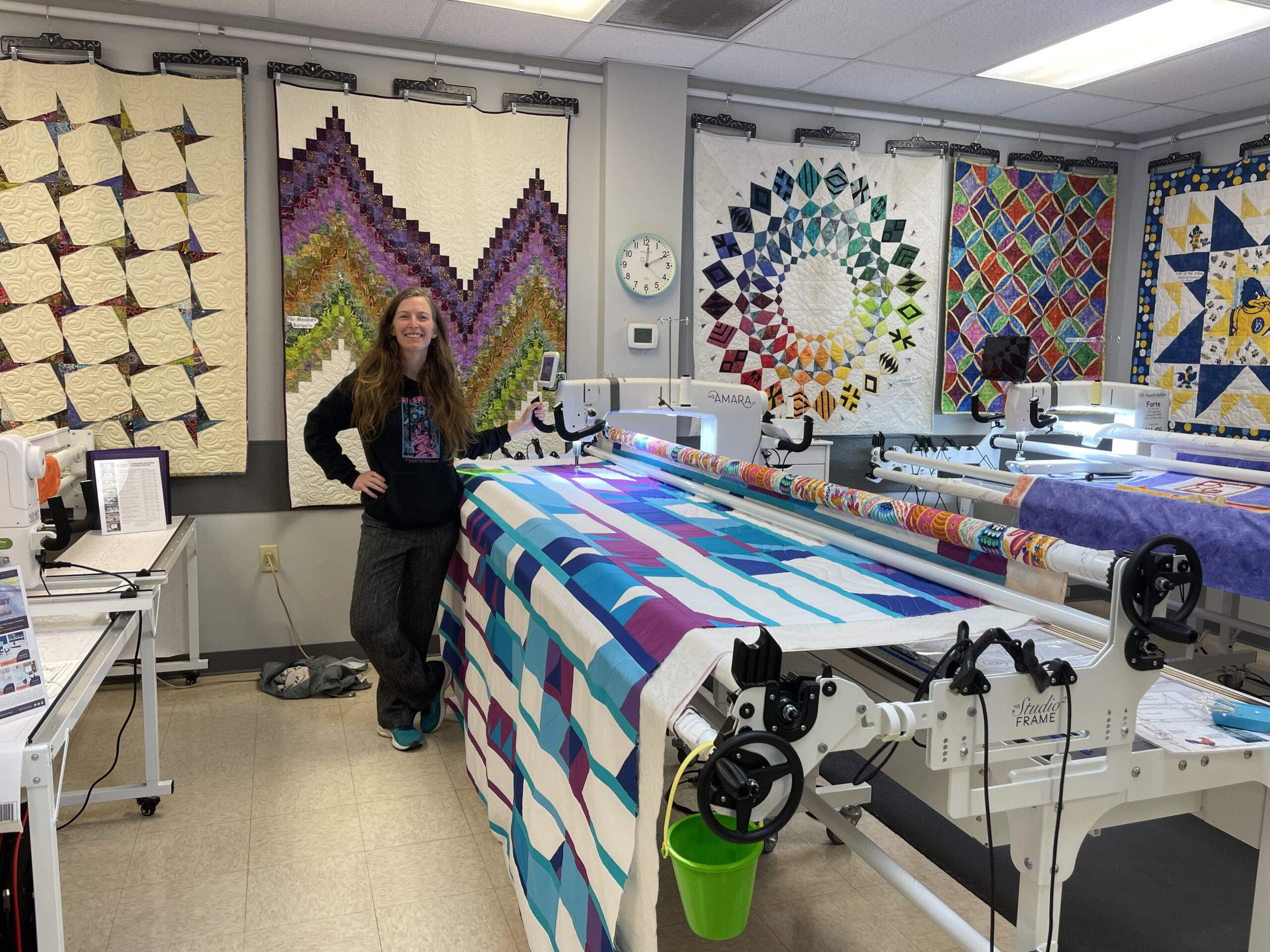
“An instrument is just as important as the sung melody”
Jenell Kesler: Tonight I’m sitting with Eliza Hardy Jones. Most of you will know her from her current work with The War On Drugs, though she’s had an extensive career in her own right, yet tonight we’re not talking about music, well we are, but in an entirely different manner. Eliza, welcome to the forum.
Eliza: Thanks for inviting me Jenell! I’m excited to talk with you about quilts today!
Jenell: Most people don’t think of musicians as having hobbies, or creating outside of the musical field, yet you’ve managed to combine the two, garnering a good bit of attention for your Song Quilts. And (laughing) to that end, I’ve been dancing from one foot to the other waiting on mine.
Eliza: I’m just putting the finishing touches on your Song Quilt! The Song Quilts project started as a multi-dimensional oral history project. I wanted to explore folk songs and folk traditions … specifically textile traditions. So I traveled around the American South and the Russian Arctic, and I interviewed women. These women would tell me stories about their lives, traditions, and then sing folk songs for me. The only rule was that the songs had to have no author, no provenance, simply songs that have just made their way across generations bubbling around in the cultural ether. I then invented a new musical notation system where rhythm is represented by shape, and pitch is represented by color. So I make EXACT musical transcriptions of songs. I was able to create this big series of quilts that examined the folk traditions from these two very different places. But since starting that project, I’ve also started making commissioned song quilts. I’ve made quilts of people’s wedding songs, or favorite songs, or just songs that meant something to them. It’s been fascinating to see how different traditional and modern songs LOOK, not just sound.
Jenell: How’d this very original concept come to you? And more so, would you speak to perceiving music as colors.
Eliza: Back in 2016 I had just released a solo album, ‘Because Become,’ and I got a message from a Russian painter named Daria Orlova and we started a conversation about art and shadows and all the rest. Through her, I met Ekaterina Sharova who founded the Arctic Art Institute. Ekaterina and I talked a lot about textile traditions and folk songs and art traditions and she said that if I came up with a fun idea to explore, that The Arctic Art Institute would host a residency for me in Arkhangelsk, Russia. I was so intrigued by the possibility of traveling to the arctic and so excited about the possibilities of thinking more deeply about folk traditions, that I invented this Song Quilts project. Ekaterina loved it and I was able to do a residency in Arkhangelsk and Murmansk.
To actually develop the concept, I immediately thought about trying to combine my love of quilts and my love of music. My Grandmother had synesthesia, which means that she saw color when she heard notes. She would always sing colors to me and ask me what notes they were. I have neither perfect pitch nor synesthesia but it was a very fun game nonetheless. So I knew that I would represent pitch in color, yet I just wasn’t sure exactly how I would do it.
In traditional notation rhythm is represented by shape … a quarter note is colored in a circle with a stem, a whole note is an empty circle with no staff. But in my notation system rhythm is represented both by shape, and the distance between notes, since rhythm is the actual distance between moments. You can see here that a quarter note for me is a 4” square, a half note would be an 8”x 4” rectangle, and an eighth note is a half square triangle. The half square triangle is a basic unit of all quilts.

Jenell: I’m sure you’re aware of the Music Notation Project. There are 8 groups of keys on the piano and these are represented by coloring each group in the order of the colors of the rainbow. Starting with red on the left, and moving across the piano to the right, orange, yellow, green, blue, purple pink, and then ending with white in the smallest group of keys on the far right. Do you subscribe to this concept, or are you a bit more free form?
Eliza: I’ve actually never heard of this, but I’m interested to learn more about it. My system is much different than this. And in fact much different from what those with synesthesia might have created. I based my system on the relationships between notes, rather than the notes themselves. So instead of assigning a color to each of the notes in the scale, I assign color relationships to harmonic relationships. I’ve named it “The Resonant Anchor” system. In music we have primary chords I, IV and V. I assign each of those as an anchor. And then the colors move towards those anchors. Each note is ordered based on its harmonic resonance, and becomes its color resonance.

So for each quilt, I can assign different colors to the resonant anchors, but I am not allowed to alter the system of how they must relate to each other. It’s a strict rule, but one that allows me to choose colors that I think best capture the spirit of the song I am quilting. One thing traditional notation can’t do is tell you what the spirit of the song might be, but hopefully my Resonant Anchor system can.
Jenell: Do you personally hear music in color?
Eliza: Before I started this project, I would have said I didn’t. I do not have synesthesia the way my Grandmother did. But through the process of changing the way I think about music, I frequently think about what kinds of colors I might use to make a song. And start to hear those songs in color.
Are there any inherent limitations to the music you can score to a quilt? I suppose I should also be asking if you concentrate on vocals or the instrumentation, and how about an a capella song?
Eliza: There are definite limitations. Because this was designed to translate folk music, I intentionally stuck to how most people understand a folk song, which is a simple melody sung over chords. So that is all that the Song Quilts represent. You can see that each row in the song quilts is separated by a one-inch sash.

Those sashes represent the chord changes. I grew up in a family that played Old-Time Appalachian music. Somebody would bang out the chords, and somebody would sing, and everything would fall into place.

But in more modern music, often the melody of an instrument is just as important as the sung melody. But my method only represents what is sung. For instance, in your Song Quilt for ‘Eyes to the Wind,’ the vocal melody is often answered with a beautiful piano melody or guitar melody. But in your quilt you’ll just see long rows of white (which represent silence). Even though the piano or guitar might be playing a melody, the voice is silent, and my method only captures the voice. It also never represents voices singing in harmony together. Just the simple melody.
Jenell: You know I have to ask this, did anyone ever ask for a quilt based on a song that wasn’t shall we say to your liking, and would that cause an uncomfortable song to get stuck in your head?
Eliza: So far, I’ve been lucky to only work on songs that I’ve enjoyed spending a lot of time with. I did have one request for a Song Quilt where the person gave me two options, a Fats Domino song, or a Misfits song. The Misfits are a punk band, and the melodies are often just one or two note melodies, so the Misfits Song Quilt would have looked VERY simple, just single colors for ages, so we decided on the more exciting Fats Domino song.
Jenell: My husband and I had the War On Drugs song ‘Eyes to the Wind’ in mind, that must have been a no-brainer for you. What happens when you’re not at all familiar with the song a client presents?
Eliza: When I was making the Russian Song Quilts, I was entirely unfamiliar with the songs. Many of the arctic folk songs are ancient, and being able to find recordings, or look more deeply into the background of the song was difficult since I don’t speak Russian or read the Cyrillic alphabet. But since I’m making exact transcriptions of the song exactly as the woman sang it for me, I really only need my recording of the woman singing to create a transcription. It’s actually much harder to make Song Quilts of modern music. For instance, the way that Adam sings ‘Eyes to the Wind’ includes a lot of syncopated rhythms and subtle changes from line to line, so it took a long time to write out the transcription. Folk songs are generally much easier!
Jenell: What are the physical steps in creating a quilt?
Eliza: The first step is always making a traditional transcription of the song, which I do by ear. I listen to the recordings (either of the women singing for the original series, or of the song that somebody has commissioned) and I carefully record the rhythm and notes and try to catch all of the subtleties. Then I use a graphic design program to map out the traditional transcription into my method. When I first do this, I use just the 7 colors of the rainbow to match the 7 pitches in a scale. It looks like this.
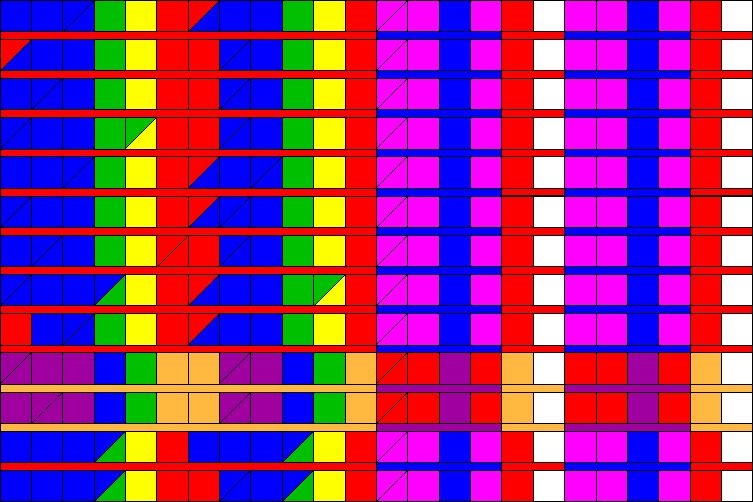
Then I pull out my fabric swatches and I try to find the perfect colors.
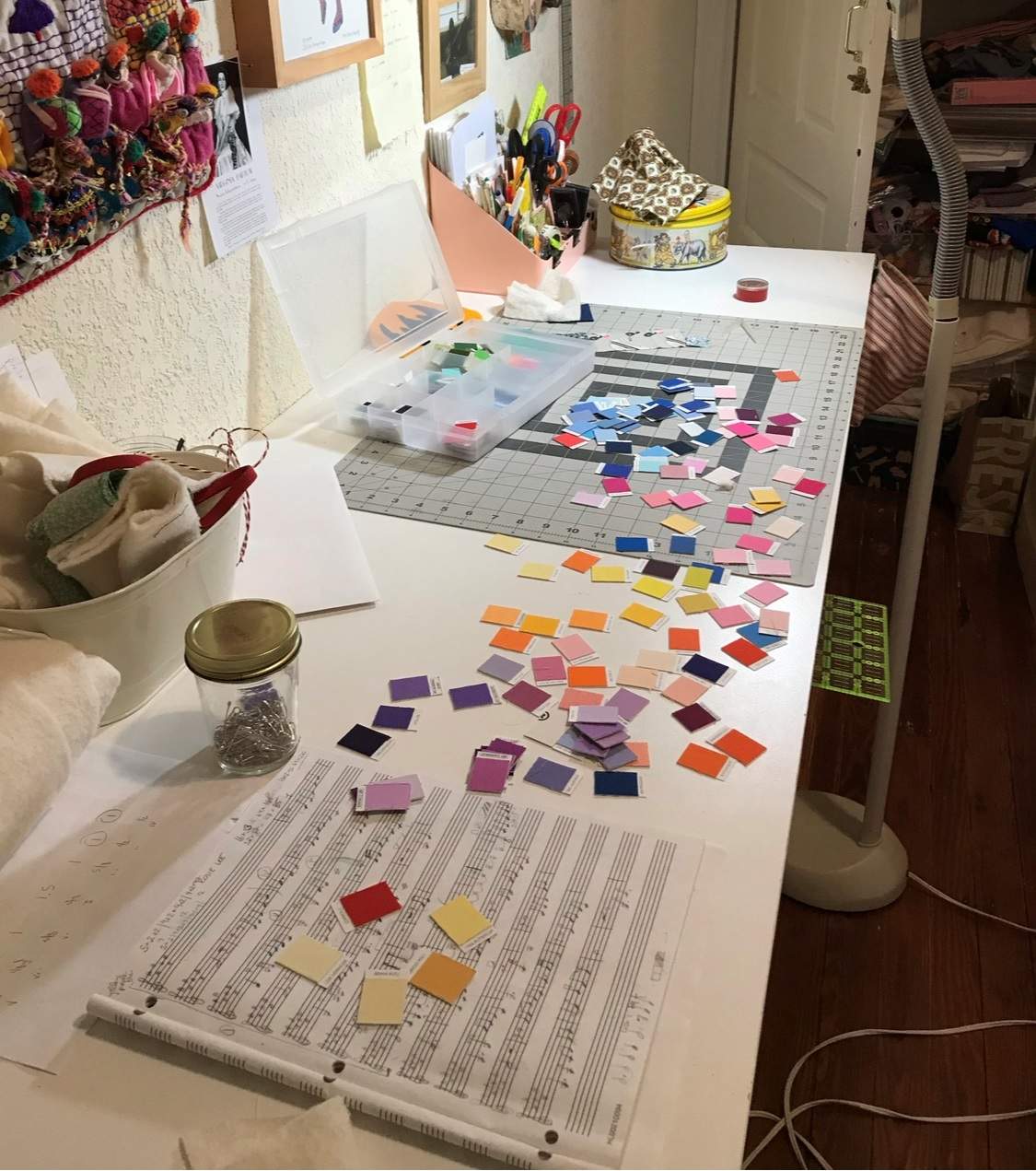
Once I pick the right colors I order the fabric, and then do all the cutting, then assemble the quilt row by row.
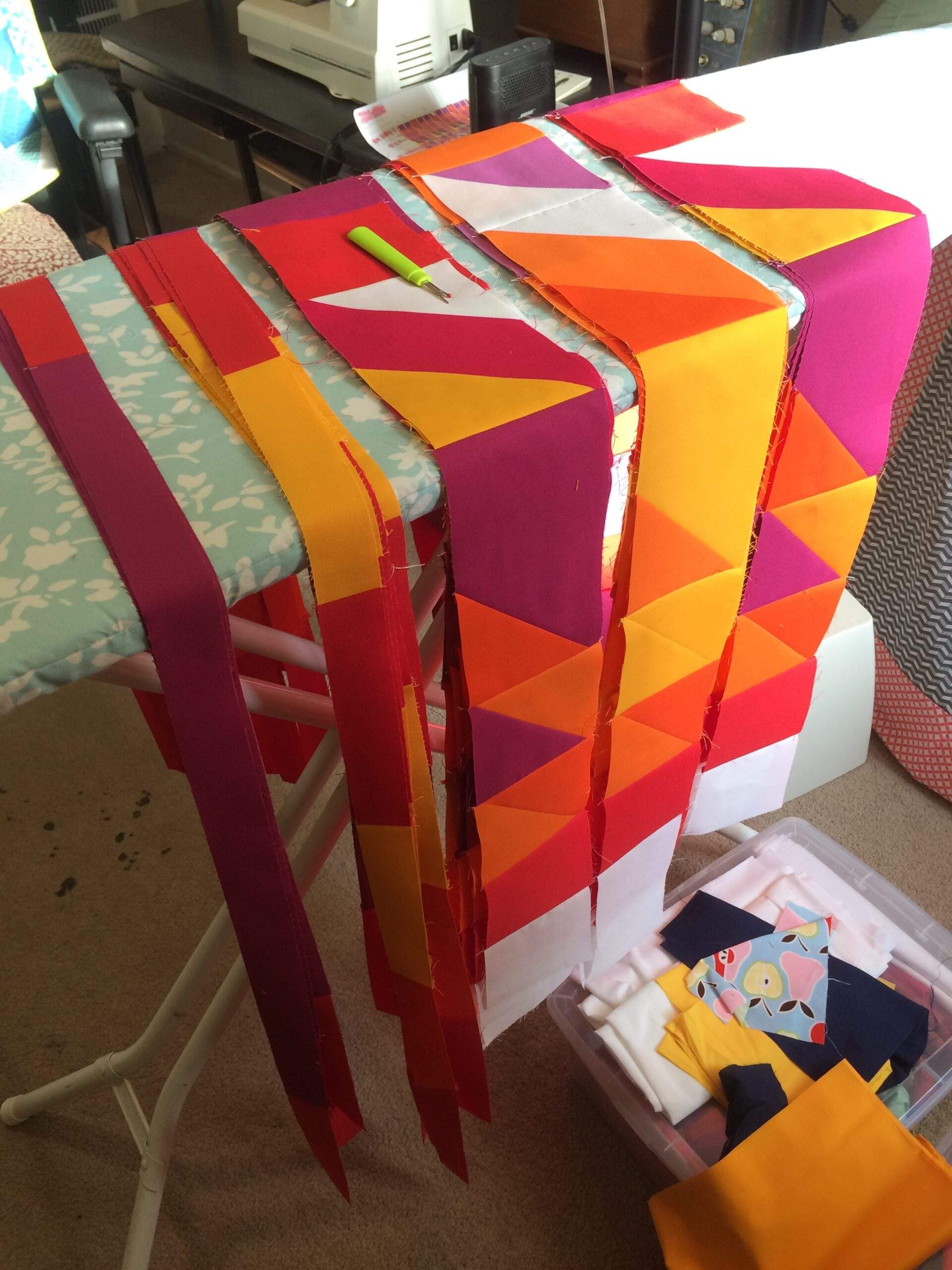
Once the top is assembled, I have to pick the backing fabric. For the initial project, I always chose backing fabric that represented something about the woman or the place the song was from. (For all of the Russian Song Quilts, I used fabric made in Russia.)
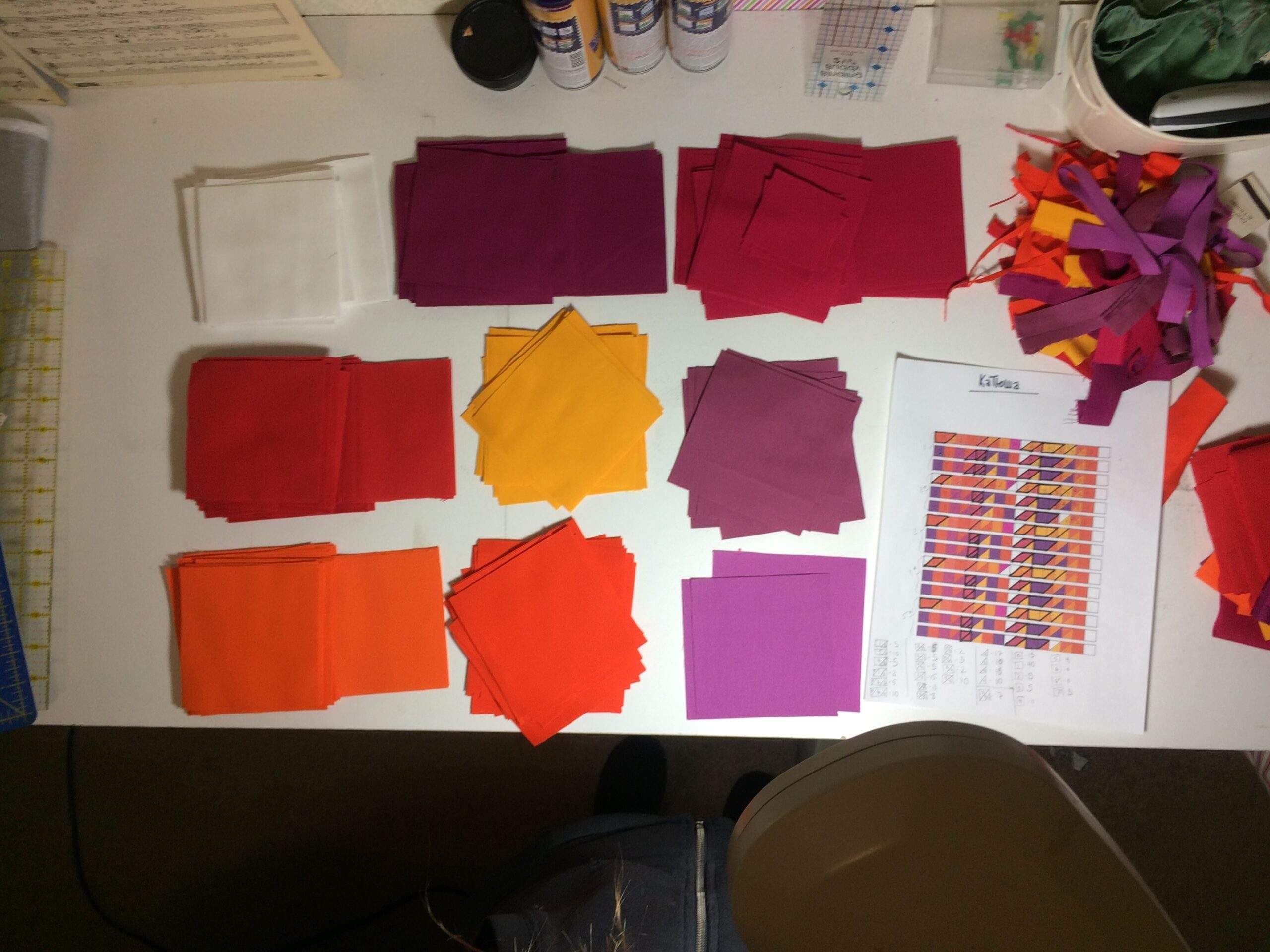
And then finally, I make “the sandwich.” In order for a quilt to be a “quilt” and not just a blanket, it must have three layers, a pieced top, soft batting in the middle, and then a backing fabric. Then you have to actually “quilt” those layers together. This quilting design allows me to add an extra layer of meaning. For the initial Song Quilts series, I would use a regional textile design as the quilting pattern.
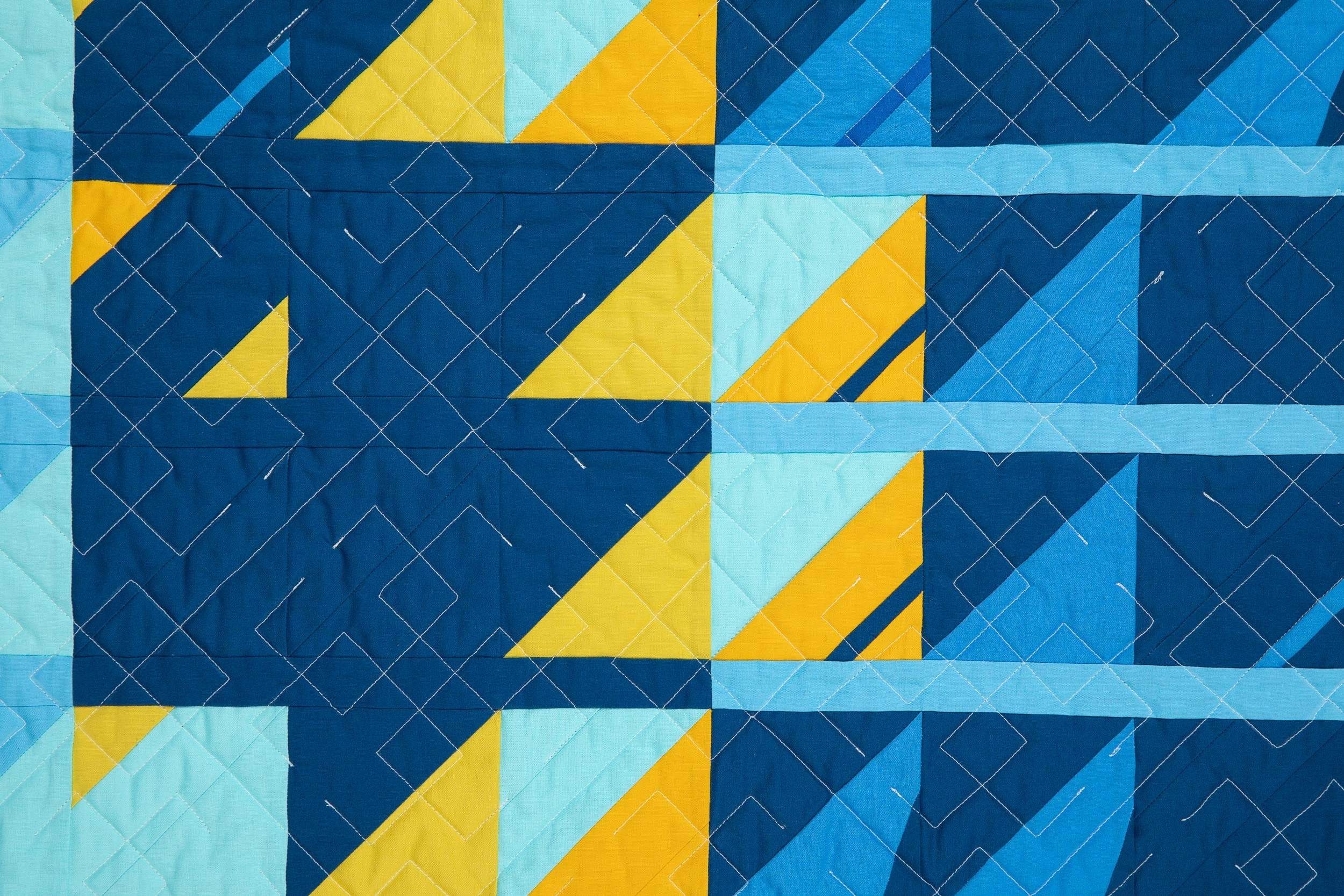
For the commission quilts, I try to think about the song, or the person and imagine what would feel best. For the quilting, I can do it by hand, on my domestic machine, or often I will rent time on a long arm machine that allows me to do more detailed quilting on a larger scale.
Jenell: Are all of your quilts commissions?
Eliza: Nope! The first series of Russian and American Song Quilts I made as an art project. I was lucky to have a series of exhibitions that culminated in a show at The International Quilt Museum. I’ve done about a dozen commissioned Song Quilts of modern music, but I also make all kinds of quilts, traditional and modern, as gifts of love, to mark major life events, or just for fun.
“Quilts are meant to bring beauty and joy and meaning to our lives”
Jenell: Do you see your quilts as art to be hung on the wall, or music to sleep under, to dream to?
Eliza: Both! I am a strong believer that quilts are meant to be used, to get dirty, to go on picnics, for sleeping, or snuggling. But that big series of Russian and American Song Quilts were always meant to be a museum exhibit, always meant to be able to hang alongside each other to ask the viewer to think more deeply about women’s work, folk traditions, and the relationship between people in two countries that have often been at odds. Quilts are meant to bring beauty and joy and meaning to our lives, and however you use them is just right.
Jenell: Quilting probably transcends time, have you gotten into the history of quilting, do you collect the work of other quilters?
Eliza: I am a major quilt historian, and read a lot about textile traditions in general. Textile creation is at the very root of our ability to create civilizations. And the quilts we make and love tell a lot about the cultures they come from. Quilting is a universal tradition, there are quilting traditions from just about every corner of the globe. I have a small collection of quilts, but I would by no means call myself a collector. Our house is stuffed to the gills with quilts already!
Jenell: We are all aware of your instruments when you’re on stage, but how about quilting tools, is there anything inherently special, say a pair of scissors that are akin to a ’65 Rickenbacker?
Eliza: Many quilters feel very strongly about their tools, and there are definitely folks who have a whole clutch of sewing machines, perhaps including a 1920s Singer Featherweight, and hand made stilettos and edge tools, and a fabric collection that includes untouchable fabric from their favorite designers that are decades old. But much like I am with my musical instruments, I am with my sewing instruments. I like a sturdy workhorse, a reliable and capable machine, a dedicated pair of fabric only scissors, and an organized fabric closet that I’m happy to cut into whenever the time is right. My Nana was a seamstress, so many of my tools were inherited from her, and I love them, but I’m not overly precious with them.
Jenell: Let me take a minute and ask what you’ve got going on musically. Any new projects, solo material?
Eliza: I have lots going on musically! I’ve been helping my brother finish a musical he wrote about the book The Milkman which has been an absolute blast. And I’m busy writing new songs for a few other projects, and hopefully a new solo album. I’ll be back out with The War on Drugs this spring, but in the meantime I’ll be making quilts and songs and spending time in the woods. And hopefully have a solo album by year’s end!
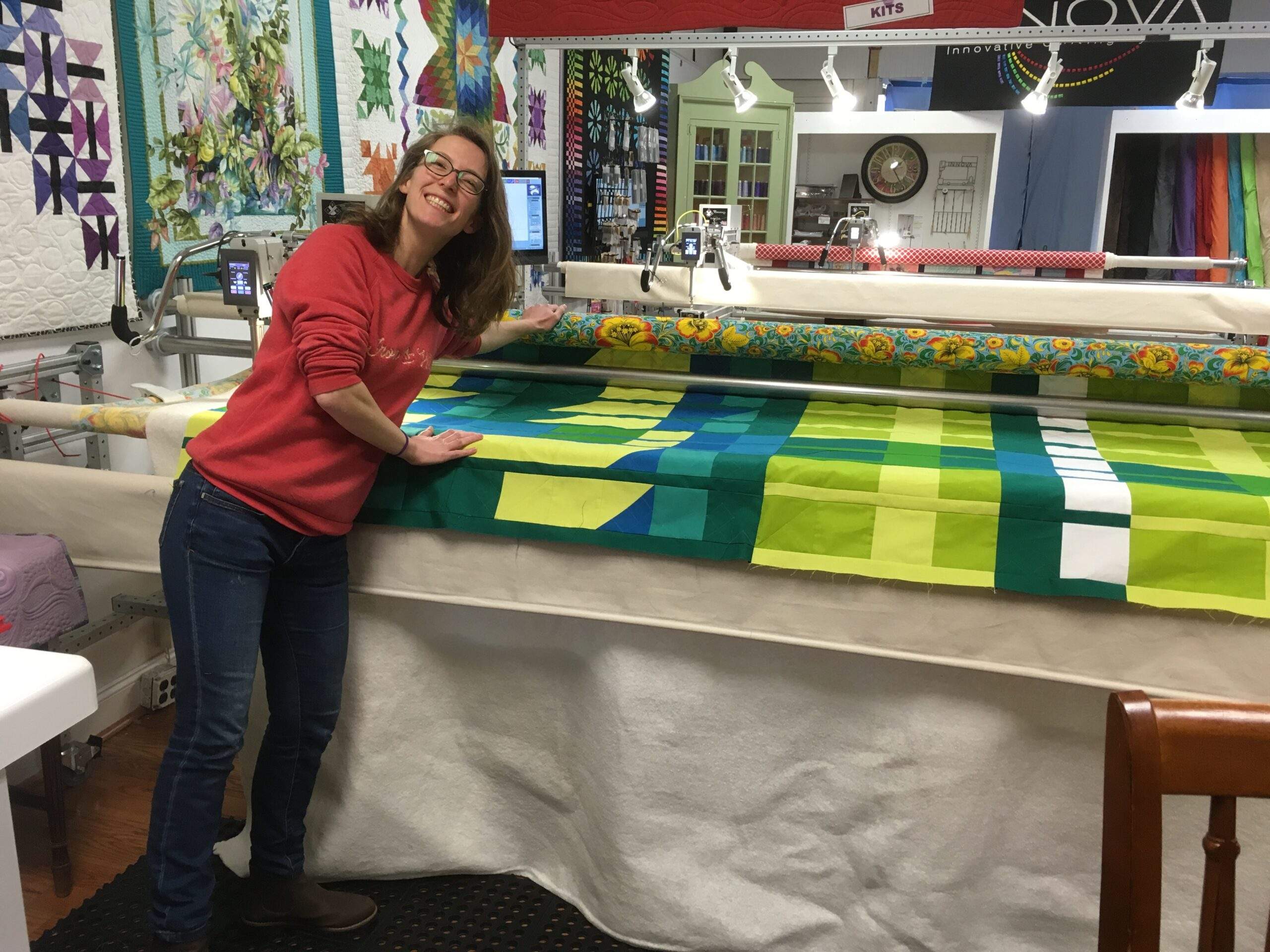
Jenell: Eliza, I sincerely want to thank you for sitting down with me, it’s been a pleasure. Please is there anything I’ve missed, and where can folks find you and your work, both music and quilts?
Eliza: Thanks so much Jenell! I love talking about quilts. I encourage folks to check out my Song Quilts website where you can see the quilts, but also hear recordings of the women singing their incredible songs and maybe even talking about their lives a little. I’ve included lots of pictures of the people and places involved in this very fun oral history project!
Jenell Kesler
Eliza Hardy-Jones Official Website / Facebook / Instagram / Twitter / Bandcamp

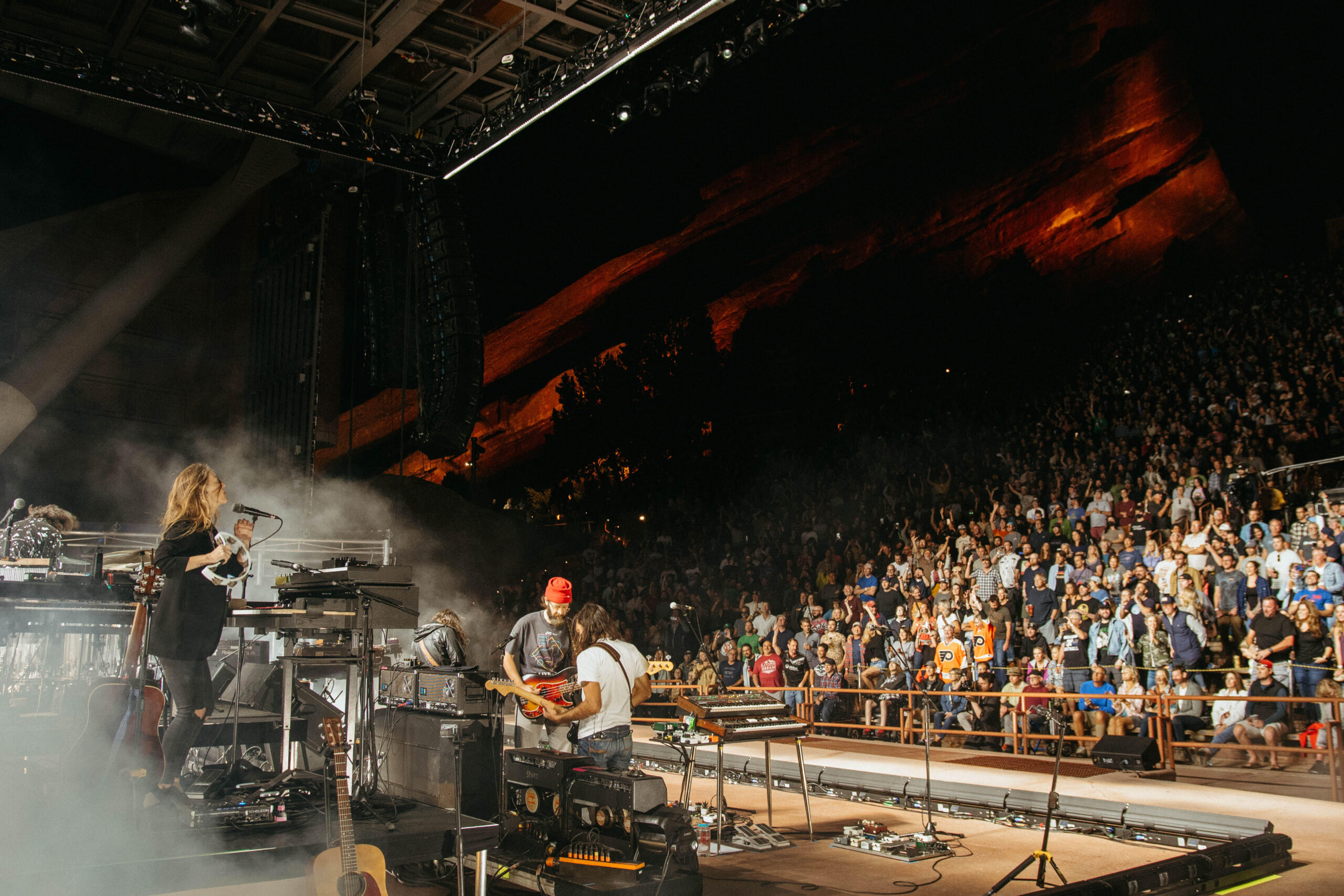



This just about as fascinating as you can get.